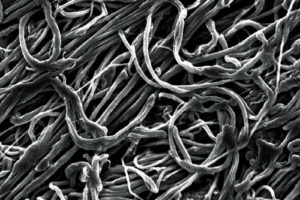
They may be ultrafine, but fibers produced using a new process developed by researchers at MIT are strong and tough enough for use in applications including protective armor and nanocomposites. The process, known as gel electrospinning, is a variation of the traditional method of gel spinning, but with electrical forces. It creates ultrafine polyethylene fibers that match or exceed the properties of strong materials including Kevlar® and Dyneema®, which are used to stop bullets in body armor.
Electrospinning combines the use of a polymer gel as the starting material with electrical forces rather than mechanical pulling to produce more highly drawn fibers. The charged fibers induce a “whipping” instability process that produces their ultrafine dimensions.
Unlike other methods, electrospinning doesn’t sacrifice fiber quality. According to MIT chemical engineering professor Gregory Rutledge, researchers typically make a tradeoff—when one characteristic is enhanced, another declines. Often, when strength is enhanced, toughness suffers because the material becomes brittle and doesn’t have the mechanism for absorbing energy, so it tends to break. This process eliminates that tradeoff.
Compared to carbon or ceramic fibers, often used in composite materials, the ultrafine fibers have similar degrees of strength but are much tougher, with lower density, able to outperform standard materials. For more information, visit www.news.mit.edu.
 TEXTILES.ORG
TEXTILES.ORG


